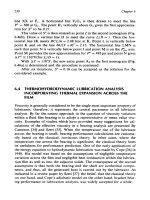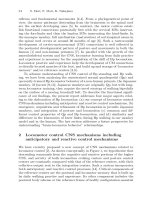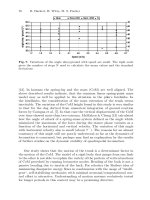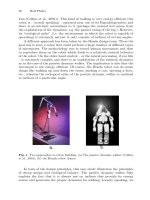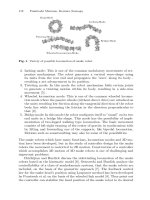Adaptive Motion of Animals and Machines - Hiroshi Kimura et al (Eds) Part 1 docx
Bạn đang xem bản rút gọn của tài liệu. Xem và tải ngay bản đầy đủ của tài liệu tại đây (557.56 KB, 20 trang )
Hiroshi Kimura, Kazuo Tsuchiya, Akio Ishiguro,
Hartmut Witte (Editors)
Adaptive Motion of Animals and Machines
Hiroshi Kimura, Kazuo Tsuchiya,
Akio Ishiguro, Hartmut Witte (Editors)
Adaptive Motion of
Animals and Machines
With 241 Figures
ABC
Hiroshi Kimura
Graduate School of Information Systems
University of Electro-Communications
1-5-1 Chofu-ga-oka, Chofu, Tokyo 182-8585, Japan
Kazuo Tsuchiya
Department of Aeronautics and Astronautics
Graduate School of Engineering
Kyoto University
Yoshida-honmachi, Sakyo-ku, Kyoto 606-8501, Japan
Akio Ishiguro
Department of Computational Science and Engineering
Graduate School of Engineering
Nagoya University
Furo-cho, Chikusa-ku, Nagoya 464-8603, Japan
Hartmut Witte
Department of Biomechatronics
Faculty of Mechanical Engineering
Technical University of Ilmenau
Pf 10 05 65, D-98684 Ilmenau, Germany
Library of Congress Control Number: 2005936106
ISBN-10 4-431-24164-7 Springer-Verlag Tokyo Berlin Heidelberg New York
ISBN-13 978-4-431-24164-5 Springer-Verlag Tokyo Berlin Heidelberg New York
Printed on acid-free paper
© Springer-Verlag Tokyo 2006
Printed in Japan
This work is subject to copyright. All rights are reserved, whether the whole or part of the material
is concerned, specifically the rights of translation, reprinting, reuse of illustrations, recitation,
broadcasting, reproduction on microfilms or in other ways, and storage in data banks.
The use of registered names, trademarks, etc. in this publication does not imply, even in the absence of a
specific statement, that such names are exempt from the relevant protective laws and regulations and
therefore free for general use.
Springer is a part of Springer Science+Business Media
springeronline.com
Printing and binding: Hirakawa Kogyosha, Japan
Preface
• Motivation
It is our dream to understand the principles of animals’ remarkable ability
for adaptive motion and to transfer such abilities to a robot. Up to now,
mechanisms for generation and control of stereotyped motions and adaptive
motions in well-known simple environments have been formulated to some
extent and successfully applied to robots. However, principles of adaptation to
various environments have not yet been clarified, and autonomous adaptation
remains unsolved as a seriously difficult problem in robotics.
Apparently, the ability of animals and robots to adapt in a real world
cannot be explained or realized by one single function in a control system
and mechanism. That is, adaptation in motion is induced at every level from
the central nervous system to the musculoskeletal system. Thus, we organized
the International Symposium on Adaptive Motion in Animals and
Machines (AMAM) for scientists and engineers concerned with adaptation
on various levels to be brought together to discuss principles at each level and
to investigate principles governing total systems.
• History
AMAM started in Montreal (Canada) in August 2000. It was organized by
H. Kimura (Japan), H. Witte (Germany), G. Taga (Japan), and K. Osuka
(Japan), who had agreed that having a small symposium on motion control,
with people from several fields coming together to discuss specific issues, was
worthwhile. Those four organizing committee members determined the scope
of AMAM as follows.
+ motion principles in nature
+ biologically inspired technical motion systems
+ nonlinear system dynamics and control
+ dynamic autonomous adaptation to terrain
+ dynamic adaptive mechanism
+ passive dynamic walking
+ autonomous pattern adaptation
+ evolution of mechanism and control/nervous system
These topics involve a broad range of background disciplines, i.e., biology,
physiology, biomechanics, non-linear system dynamics, and robotics. It is
usually difficult for people from different disciplines to discuss specific is-
sues. Therefore, in order to ease this problem we invited nine speakers, each
of whom had an impressive academic background in his field. Finally, 41
papers, including nine keynote lectures, were presented in single-track style
over four days. Because the quality of each presentation, the intensive discus-
sion concentrating on the single issue of adaptive motion, and the interaction
VI
among people of different backgrounds were so well received, we agreed on
holding the 2nd AMAM in Kyoto (Japan) in March 2003.
For the 2nd AMAM, the international organizing committee (AMAM
IOC) was formally organized. We received sponsorship from the Japan Soci-
ety for the Promotion of Science (JSPS) and co-sponsorship from the CREST
Program of the Japan Science and Technology Corporation (JST). While
keeping the symposium style of AMAM2000, 59 high-quality papers, includ-
ing nine invited keynote lectures, were presented in single-track style over
five days.
The 3rd AMAM was held in Ilmenau (Germany) in September 2005. The
proceedings of AMAM2005 will be published on DVD. The members of the
current AMAM IOC are:
Kazuo Tsuchiya, general chair Auke Ijspeert
Hiroshi Kimura, secretary Martin Buehler
Akio Ishiguro, treasurer Avis H. Cohen
Hartmut Witte
• Publication
This proceedings comprises 23 papers selected from the CD-ROM proceed-
ings of the 1st and 2nd AMAMs. The topics can be loosely placed into six
categories: (1) motion generation and adaptation in animals; (2) adaptive
mechanics; (3) machine design and control; (4) bipedal locomotion utilizing
natural dynamics; (5) neuro-mechanics and CPG and/or reflexes; and (6)
adaptation at higher nervous levels.
• Towards the Future
What we discuss, e.g., science vs engineering or biology vs robotics, is not
one of the key issues of AMAM. When we solve complicated problems, it
is desirable to proceed with analysis and synthesis concurrently. It is well
known that analysis by synthesis is a worthwhile and important methodology
to understand underlying principles. We hope AMAM marks the beginning
of a new interdisciplinary research field where science and engineering are
merged.
Tokyo, Kyoto, Nagoya (Japan) and Ilmenau (Germany) Hiroshi Kimura
November 2005 Kazuo Tsuchiya
Akio Ishiguro
Hartmut Witte
Contents
Part 1 Motion Generation and Adaptation in Animals
Overview of Adaptive Motion in Animals and Its Control
Principles Applied to Machines 3
Avis H. Cohen
Robust Behaviour of the Human Leg 5
Reinhard Blickhan, Andre Seyfarth, Heiko Wagner, Arnd Friedrichs,
Michael G¨unther, Klaus D. Maier
1 Introduction. . . . . . . . . . . . . . . . . . . . . . . . . . . . . . . . . . . . . . . . . . . . . . . . . 5
2 Results 6
3 Perspective 14
Control of Hexapod Walking in Biological Systems 17
Holk Cruse, Volker D¨urr, Josef Schmitz, Axel Schneider
1 Walking:anontrivial behavior 17
2 Control of the step rhythm of the individual leg . . . . . . . . . . . . . . . . . . 19
3 Control of the selector network: coordination between legs. . . . . . . . . 19
4 Controlofthe swingmovement 21
5 Control of the stance movement and coordination of supporting legs 24
6 Conclusion 26
Purposive Locomotion of Insects in an Indefinite Environment 31
Masafumi Yano
1 Introduction. . . . . . . . . . . . . . . . . . . . . . . . . . . . . . . . . . . . . . . . . . . . . . . . . 31
2 Motioncontrolsystem 32
3 Centralpatterngenerator model 35
4 Results 38
5 Discussion 38
Control Principles for Locomotion –Looking Toward Biology . 41
Avis H. Cohen
1 Introduction to Central Pattern Generators and their sensory control 41
2 CPGand muscle activation 41
3 Sensoryfeedback 45
4 Summaryand conclusions 49
Higher Nervous Control of Quadrupedal vs Bipedal Locomotion
in Non-Human Primates; Common and Specific Properties 53
Shigemi Mori, Futoshi Mori, Katsumi Nakajima
1 Introduction. . . . . . . . . . . . . . . . . . . . . . . . . . . . . . . . . . . . . . . . . . . . . . . . . 53
VIII
2 Locomotor control CNS mechanisms including anticipatory and re-
activecontrolmechanisms 54
3 Emergence, acquisition and refinement of Bp locomotion in Juvenile
Japanesemonkeys 56
4 Common and different control properties of Qp and Bp locomotion . 58
5 Similarity and difference in the kinematics of lower limbs during Bp
walking between our monkey model and the human . . . . . . . . . . . . . . 59
6 Summaryand discussion 60
Part 2 Adaptive Mechanics
Interactions between Motions of the Trunk and the Angle
of Attack of the Forelimbs in Synchronous Gaits of the Pika
(Ochotona rufescens) 69
Remi Hackert, Hartmut Witte, Martin S. Fischer
1 Introduction. . . . . . . . . . . . . . . . . . . . . . . . . . . . . . . . . . . . . . . . . . . . . . . . . 70
2 Preliminiary question: do pikas prefer one forelimb as trailing limb? 70
3 Trajectories of the centre of mass of pikas in half-bound gait . . . . . . 72
4 Doestheangleof attack couplewith speed? 74
5 Conclusions 75
On the Dynamics of Bounding and Extensions: Towards the
Half-Bound and Gallop Gaits 79
Ioannis Poulakakis, James Andrew Smith, Martin Buehler
1 Introduction. . . . . . . . . . . . . . . . . . . . . . . . . . . . . . . . . . . . . . . . . . . . . . . . . 79
2 Bounding experiments with Scout II . . . . . . . . . . . . . . . . . . . . . . . . . . . . 80
3 Self-stabilization in the SLIP . . . . . . . . . . . . . . . . . . . . . . . . . . . . . . . . . . 81
4 Modeling the Bounding Gait . . . . . . . . . . . . . . . . . . . . . . . . . . . . . . . . . . 82
5 Local stability of passive bounding . . . . . . . . . . . . . . . . . . . . . . . . . . . . . 85
6 Thehalf-bound androtarygallop gaits 85
7 Conclusion 88
Part 3 Machine Design and Control
Jumping, Walking, Dancing, Reaching: Moving into the
Future. Design Principles for Adaptive Motion 91
Rolf Pfeifer
1 Introduction. . . . . . . . . . . . . . . . . . . . . . . . . . . . . . . . . . . . . . . . . . . . . . . . . 91
2 Designprinciples: overview 93
3 Information theoretic implications of embodiment . . . . . . . . . . . . . . . . 97
4 Exploring “ecological balance”—artificial evolution and morphogen-
esis 102
5 Discussionand conclusions 104
IX
Towards a Well-Balanced Design in the Particle Deflection Plane
107
Akio Ishiguro, Kazuhisa Ishimaru, Toshihiro Kawakatsu
1 Introduction 107
2 Lessons from biological findings . . . . . . . . . . . . . . . . . . . . . . . . . . . . . . . . 108
3 Themodel 109
4 Proposedmethod 110
5 Preliminarysimulationresults 111
6 Conclusionand futurework 114
Experimental Study on Control of Redundant 3-D Snake Robot
Based on a Kinematic Model 117
Fumitoshi Matsuno, Kentaro Suenaga
1 Introduction 117
2 Redundancy controllable system . . . . . . . . . . . . . . . . . . . . . . . . . . . . . . 119
3 Kinematic model of snake robots . . . . . . . . . . . . . . . . . . . . . . . . . . . . . . 119
4 Condition for redundancy controllable system . . . . . . . . . . . . . . . . . . . 122
5 Controllerdesignfor main-objective 123
6 Controllerdesignfor sub-objective 124
7 Experiments 125
8 Conclusion 125
Part 4 Bipedal Locomotion Utilizing Natural Dynamics
Simulation Study of Self-Excited Walking of a Biped
Mechanism with Bent Knee 131
Kyosuke Ono, Xiaofeng Yao
1 Introduction 131
2 The analytical model and basic equations . . . . . . . . . . . . . . . . . . . . . . . 132
3 Theresults ofsimulation 135
4 Conclusion 140
Design and Construction of MIKE;
a 2-D Autonomous Biped Based on Passive Dynamic Walking 143
Martijn Wisse, Jan van Frankenhuyzen
1 Introduction 143
2 Footshape 144
3 McKibben muscles as adjustable springs 146
4 Pneumaticsystem 148
5 Pressure control unit 149
6 Walkingexperiments 151
7 Conclusion 153
X
Learning Energy-Efficient Walking with Ballistic Walking 155
Masaki Ogino, Koh Hosoda, Minoru Asada
1 Introduction 155
2 Ballistic walking with state machine . . . . . . . . . . . . . . . . . . . . . . . . . . . . 156
3 Energyminimization by alearningmodule 159
4 Comparing with human data . . . . . . . . . . . . . . . . . . . . . . . . . . . . . . . . . . 161
5 Discussion 163
Motion Generation and Control of Quasi Passsive Dynamic
Walking Based on the Concept of Delayed Feedback Control . 165
Yasuhiro Sugimoto, Koichi Osuka
1 Introduction 165
2 Modelof thewalkingrobot 166
3 Stability of passive dynamic walking . . . . . . . . . . . . . . . . . . . . . . . . . . . . 167
4 DFC-basedcontrolmethod 168
5 Computer simulation . . . . . . . . . . . . . . . . . . . . . . . . . . . . . . . . . . . . . . . . . 171
6 Conclusionand futurework 174
Part 5 Neuro-Mechanics & CPG and/or Reflexes
Gait Transition from Swimming to Walking: Investigation of
Salamander Locomotion Control Using Nonlinear Oscillators . 177
Auke Jan Ijspeert, Jean-Marie Cabelguen
1 Introduction 177
2 Neuralcontrolof salamanderlocomotion 178
3 Mechanicalsimulation 179
4 Locomotioncontroller 180
5 Discussion 186
Nonlinear Dynamics of Human Locomotion: from Real-Time
Adaptation to Development 189
Gentaro Taga
1 Introduction 189
2 Real-time adaptation of locomotion through global entrainment . . . . 190
3 Anticipatory adjustment of locomotion through visuo-motor coor-
dination . . . . . . . . . . . . . . . . . . . . . . . . . . . . . . . . . . . . . . . . . . . . . . . . . . . . 195
4 Computational “lesion” experiments in gait pathology . . . . . . . . . . . . 197
5 Freezing and freeing degrees of freedom in the development of loco-
motion 199
6 Concludingcomments 201
Towards Emulating Adaptive Locomotion of a Quadrupedal
Primate by a Neuro-musculo-skeletal Model 205
Naomichi Ogihara, Nobutoshi Yamazaki
XI
1 Introduction 205
2 Model 206
3 Results 211
4 Discussion 214
Dynamics-Based Motion Adaptation for a Quadruped Robot . 217
Hiroshi Kimura, Yasuhiro Fukuoka
1 Introduction 217
2 Adaptive dynamic walking based on biological concepts . . . . . . . . . . . 218
3 Entrainment between pitching and rolling motions . . . . . . . . . . . . . . . 221
4 Adaptivewalkingon irregularterrain 223
5 Conclusion 225
A Turning Strategy of a Multi-legged Locomotion Robot 227
Kazuo Tsuchiya, Shinya Aoi, Katsuyoshi Tsujita
1 Introduction 227
2 Model 228
3 Stability analysis of walking . . . . . . . . . . . . . . . . . . . . . . . . . . . . . . . . . . . 229
4 Turningwalkcontrol 234
5 Conclusion 235
A Behaviour Network Concept for Controlling Walking
Machines 237
Jan Albiez, Tobias Luksch, Karsten Berns, R¨udiger Dillmann
1 Introduction 237
2 Activation, activity, target rating and behaviours . . . . . . . . . . . . . . . . 238
3 Thewalkingmachine BISAM 241
4 Implementingabehaviour network 242
5 Conclusionand outlook 243
Part 6 Adaptation at Higher Nervous Level
Control of Bipedal Walking in the Japanese Monkey,
M. fuscata : Reactive and Anticipatory Control Mechanisms 249
Futoshi Mori, Katsumi Nakajima, Shigemi Mori
1 Introduction 249
2 Reactive control of Bp locomotion on a slanted treadmill belt . . . . . . 250
3 Reactive and anticipatory control of Bp locomotion on an obstacle-
attachedtreadmillbelt 253
4 Summary 257
Dynamic Movement Primitives –A Framework for Motor
Control in Humans and Humanoid Robotics 261
Stefan Schaal
1 Introduction 261
XII
2 Dynamic movement primitives . . . . . . . . . . . . . . . . . . . . . . . . . . . . . . . . . 263
3 Parallels in biological research . . . . . . . . . . . . . . . . . . . . . . . . . . . . . . . . . 269
4 Conclusion 275
Coupling Environmental Information from Visual System to
Changes in Locomotion Patterns: Implications for the Design
of Adaptable Biped Robots 281
Aftab E. Patla, Michael Cinelli, Michael Greig
1 Introduction 281
2 The twelve postulates for visual control of human locomotion . . . . . . 282
3 Challenges for applying this knowledge to building of adaptable
bipedrobots 284
4 Avoiding collisions with obstacles in the travel path . . . . . . . . . . . . . . 286
5 Avoiding stepping on a specific landing area in the travel path . . . . . 293
6 Conclusions 296
Part 1
Motion Generation and Adaptation
in Animals
Overview of Adaptive Motion in Animals and
Its Control Principles Applied to Machines
Avis H. Cohen
University of Maryland, Biology Department and Institute for Systems Research,
College Park, MD 20742, USA
Animals have developed their locomotor strategies and control mecha-
nisms under the intense pressure of the need to survive and reproduce. They
must escape from predators and capture prey. They also must use as little
energy as possible in order to preserve their resources. With this in mind,
roboticists might well look to biology for design and control principles. Thus,
in the articles that follow the reader is offered a collection of observations and
suggestions from researchers who have spent many years of experimenting on
a range of animals, including both vertebrates and invertebrates.
The perspectives bring an increasing level of complexity. Reinhard Blick-
han brings the mechanics of the organism into the picture, and argues that we
behave with ease and without being overwhelmed by the complicated task
in dynamic situations such as running, hopping or jumping. Holk Cruse
uses nothing by sensory feedback to control his robots. His ideas have been
developed through observations of an insect, the stick insect, that during
slow walking are using sensory feedback almost exclusively in the control of
their movements. In the overview I offer, I introduce the concept of the central
pattern generator (CPG) that provides feedforward control signals to pattern
muscle activity during locomotion of all animals. The CPG strongly interacts
with sensory feedback. Some of the universal and some of the less universal
control principles are offered as potential strategies for robots. Masafumi
Yano offers a perspective that incorporates sensorimotor integration, me-
chanics and descending control from the brain. This rich viewpoint illustrates
the power of the fully integrated organism to survive in an indefinite environ-
ment. Finally, Shigemi Mori, demonstrates the flexibility of the sub-human
primate control of locomotion. He shows clearly that the sub-human primate,
M fuscata, are able, with extensive training, to walk bipedally, even though
their normal locomotion is quadrupedal. This surprising results shows that
the sub-human primate locomotor control system is capable of more plas-
ticity even in such a basic movement as locomotion than had been thought
possible.
Robust Behaviour of the Human Leg
Reinhard Blickhan, Andre Seyfarth, Heiko Wagner, Arnd Friedrichs,
Michael G¨unther and Klaus D. Maier
Dpt. Biomechanics, Institute of Sportscience, D-07740 Jena, Germany
Abstract. The human leg with segments, joints and many muscles is a complicated
device. Yet, in dynamic situations such as running, hopping or jumping we behave
with ease and without being overwhelmed by the complicated task. We argue that
this is possible due to a careful arrangement and fine tuning of all properties from
which stability and robustness emerges. Robust and stable systems are easy to
control.
1 Introduction
Wheeled vehicles are able to economically cover long distances as long as the
substrate is sufficiently convenient. On rough terrain legged systems are of
advantage. They can use defined footholds, can jump across obstacles and can
orient their bodies. However this results in a much higher degree of freedom of
the movement system. Wheeled vehicles have a degree of freedom of two. The
frontal movement is powered by the motor, the lateral movement is enabled
by the steering movements of the driver. In contrast animals and humans can
also raise and rotate their bodies. In addition each of the multisegmented
body appendages has additional degrees of freedom (ca. 7). This is the main
reason for the enormous difficulty to control legged robots.
Most walking machines are slow. This facilitates control. Another strategy
is to reduce degrees of freedom. Examples for this strategy are mixed wheeled
and legged systems and pantograph legs [1]. The only fast machines built
so far, are the hopping machines and their successors built at the MIT-leg
laboratory [2]. Here the construction not only used reduced degrees of freedom
but also the inherent dynamics provided by elastic telescope springs. This can
also be seen as a way to reduce the complexity of the control system. The
control system determines the angle of attack of the leg and the time of
telescopic expansion of the pneumatic spring. In fact bouncing is due to the
principal roughness of legged locomotion, where the leg is facing an impact at
each touch down, the only mode of fast locomotion. A springy leg determines
the time course of force generation and thus facilitates leg control. If this
is not guaranteed the controller must deliver its decisions within the short
contact times (see below). Everybody who observed the walking of artificial
quadrupeds knows that this demand is far from present possibilities.
Technical walking and running is per se inspired from natural examples.
With respect to the question how to solve the formidable task of locomotion
6 Reinhard Blickhan et al.
control it is again worthwhile to examine nature. We are used to talk about
central pattern generators, reflex loops, and heterarchic control. However,
we have neglected for many years the intimate relationship between the me-
chanical properties of the system and those of the control. Recently several
studies have revealed their relevance and some have even coined the contra-
dicting term ”neuromechanics” for a newly emerging field. Let me give some
prominent examples. The pendulum mechanism for walking as championed
by Hemami [3], Cavagna et al. [4], and Mochon and McMahon [5] has been
known for many years. However with respect to robotics the break through
came with the studies of McGeer [6] who constructed simple passive walkers
to support his calculations. Physical modelling helped him to understand,
that the length relation between shank and thigh is not just an accident of
evolution but is necessary for swing leg to clear ground. In many studies [7,8]
we have put forward that many legged systems in nature such as crabs and
cockroaches use the same basic dynamics during locomotion as vertebrates.
During fast locomotion the legs interact to operate like a single spring. Re-
cent realisations in different machines confirm the elegance of this approach
(Full, pers. comm.). In fact the sprawled posture of the arthropods generally
interpreted in terms of static stability has turned out to be a measure to
increase stability of locomotion in the horizontal direction. Disturbances at
the legs are compensated due to passive features of the system [9,10]. It is
important to realise that footing of each leg becomes much less critical. Even
small and imprecise neural networks are sufficient for control.
It is well known in mechanics that systems described by coupled non-
linear equations can behave very different depending on initial conditions
and selected parameters. They may display unpredictable chaotic behaviour
or may converge to stable situations e.g. limiting cycles. Pedal systems are
per se nonlinear. In addition, in biological systems the comprising materials
have complicated properties. By applying a series of models from very simple
lumped-parameter models to multi-body models with many degrees of free-
dom combined with experimental investigations we try to identify principles
of operation of the human leg. Recently, we focus on stability.
2 Results
2.1 The global properties of the human leg during running
Running as a bouncing gait can be described by a simple lumped parameter
model: the spring-mass system [11] (Fig.1). The system generates an impact
onto the ground depending on landing velocity. Depending on the stiffness
of the spring the contact time can be short (stiff spring) or long (compliant
spring). The distribution of horizontal force is described by the angle of at-
tack of the system. For the case of symmetric operation deceleration is equal
to acceleration and continuous locomotion possible. The point of operation of
such a system is partly set by physical physiological conditions. The friction
Robust Behaviour of the Human Leg 7
coefficient limits the angle of attack. The amplitudes of the vertical oscilla-
tion should be small to facilitate visual sensation and diminish the cost of
locomotion. This is due to the fact that small oscillations reduce the vertical
force and enhance contact time which can be generated with slower muscles.
Fig. 1. Simple spring-mass system describing hopping running and jumping
Recent observations (Seyfarth, Geyer, pers. com.) are signalling that other
issues may be of similar importance. A small deviation in the angle of attack
of the leg spring at touch down results in net acceleration or deceleration of
the system. Imagine that the leg would continue the same landing strategy
i.e. the same angle of attack at the next step. Due to the acceleration during
the previous step there is now an increasing or decreasing mismatch between
speed and angle of attack. For close to natural leg stiffness the angles of
attack used by the human runner are within a range where running may be
stable with respect to speed. Slight mismatches in the motor program are
compensated by the behaviour of the system.
2.2 The contribution of the different joints
Due to the degrees of freedom of a system with two joints the quasi-elastic
operation of the leg in principle could be realised by compensating inelastic
operation of the two joints. Experimental observations [12] have shown, that
quasi-elastic operation is a good first approximation. (The deviations will be
discussed below.) During hopping knee and ankle joint are operating largely
synchronous. During running the knee joint in general reaches the point of
maximum bending slightly earlier than the ankle joint. In the long jump the
goal of maximum jumping distance results in a similar synchronous operation
of the joints. Synchronous operation seems to be of advantage [13].
Copying nature in its essentials one could envision a robot leg built of three
segments of equal length with built in rotational springs. Unfortunately, such
a system is highly unstable. After a short rotation synchronisation alters.
8 Reinhard Blickhan et al.
Fig. 2. Starting from a symmetric condition with linear rotational springs at the
joints either the knee or the ankle joint over extents.
Flexion in one joint is accompanied by extension in the other (Fig.2). The
joints are working against each other. In overextending joints torque changes
sign. Such a highly unstable situation would impose serious demands on any
control system. A closer look to nature offers a basket with solutions [14].
One answer is geometry: Imitating the arrangement of leg segments of hu-
man runners result in a considerable enhancement of the synchronous working
range. An additional improvement is possible by introducing slightly nonlin-
ear spring characteristics. Another measure is to introduce springs spanning
two joints.
2.3 Coping with losses
Any real mechanical system has to cope with losses due to friction. These
might be reduced by improving the joints. However, during running quite dif-
ferent sources of loss must be considered. Running is generated by the cyclic
operation of human legs. The horizontal velocity of the foot necessarily oscil-
Robust Behaviour of the Human Leg 9
lates from zero during contact with the substrate to a value of about double
running speed during the aerial phase. Similarly, in vertical direction the foot
comes to a sudden hold at touch down. The strategy to adapt the velocity of
the foot to ground speed at touch down would be highly demanding for con-
trol systems. Especially, in axial direction the corresponding demand would
require active leg shortening with velocities of about half running speed. In
addition, the necessary active accelerations and the decrease in energy storage
would increase cost of locomotion.
Instead, the human runner accepts the impact due to the sudden deceler-
ation of the distal masses. The properties of the heel pad, of the sole of the
running shoes, the viscoelastic suspension of the muscles (Fig.3), comprising
a large part of the distal masses [13] diminish the amplitude and rise-time of
the reaction force at touch down. This critically damped impact entails an
unavoidable loss. To maintain running speed, the runner is forced to work.
The work could be done at different joints. As the main losses occur in axial
direction of the leg it is plausible to compensate the losses by active length-
ening of the leg. Runners do that by landing with the knees bent, thereby
diminishing the impact on all proximal joint surfaces, and by straightening
at take of. This lengthening of the leg- and knee-spring can be provided by
a drive in series to the spring.
2.4 Muscle properties and attractive legs
The serial arrangement of active and passive elements introduces another
complication. Now, the muscle-tendon complex as a whole must guarantee
spring-like operation. Muscles have complicated nonlinear behaviour charac-
terised by the force-displacement and force-velocity characteristics. By work-
ing at the ascending slope of the force-displacement curve quasi-elastic op-
eration of the muscle could be guaranteed. More complicated to deal with is
the force-velocity curve. The force-velocity curve can be understood as an im-
portant part of the gears of the locomotor system. While pulling at the drive
the forces are high. With shortening speed the muscle’s capabilities of force
generation diminish. Ideally the muscle-tendon complex takes advantage of
energy storage in the tendon and apodemes and simultaneously of the cheap
eccentric force generation. This is exactly what happens during long jump
[15]. The tendon is stretched immediately after touch down (Fig.4). The rise
in force is dominated by muscle recruitment and eccentric force enhancement
is easy to maintain due to the eccentric operation of the whole leg. During
take off the elastic recoil of the tendon powers straightening of the knee as
well as prolonged eccentric loading of the muscle. After the load has fallen
below the isometric point of operation muscle shortening dominates. Such a
co-operation requires a delicate tuning between muscle properties and proper-
ties of the passive tissue. Only technical drives with muscle like characteristics
could take advantage of this strategy.
10 Reinhard Blickhan et al.
Fig. 3. Viscoelastic suspension of wobbling masses reduce the sharpness of the
impact at touch down. Left: anthropomorphic model; lumped-parameter model
We have seen that under certain conditions the spring might help to
stabilise locomotion. A springy leg confronted with a rough ground returns
automatically to the point of equilibrium. A vertically oscillating spring-mass
system without damper would do this infinitely despite of any disturbances.
But we have seen, that the human leg entails serial arrangements of elastic
elements and musculature (Fig.5). It is by no means obvious how such a
system reacts to axial disturbances.
For cyclic systems the Ljapunov-Criteria can be used to examine whether
the system asymptotically returns to the prescribed path after disturbance
[16]. It assumes an exponential return to the undisturbed condition in the
state space. The local slope of this return can be determined from the Eigen-
values of the Jacobian of the equations of motion. In our case with changing
conditions during eccentric and concentric periods of the loading cycle these
criteria can be taken as a first hint together with numeric simulations. More
advanced mathematical methods support our results.
Robust Behaviour of the Human Leg 11
Fig. 4. Time course of strain of the serial elastic element (tendon and apodeme) and
the contractile element. dashed line: positive slope or lengthening.(after Seyfarth,
et al., 1999)
The results of our calculations show that for a leg model consisting of two
massless segments and a knee extensor stabilisation is only possible if the
Hill-type muscle with a realistic force length curve is paralleled by a spring
and the joint is described realistically including a moving joint axis. In fact
stabilisation requires a fine tuning of all these properties (Fig.6).
Especially if the antagonist is spanning two joints antagonistic systems
can provide stability with minor requirements with respect to tuning [17].
This is achieved at the cost of co-activation. For the single extensor system
described above the activation of the muscle providing a suitable input for
the cyclic movement is uniquely determined. For antagonistic systems this
is not the case, the system is underdetermined. However, we can calculate
activation pattern which provide stability for the system. The stability crite-
rion serves as the necessary additional condition in the system of differential
equations. With this approach we find stability for very simple activation
patterns. Both muscles are activated simultaneously working against each
other in the deflection phase. During the extension phase the flexor is de-
activated earlier. New movements can be learned with co-activated muscles
providing maximum stability. The neural network controlling the movement
then learns to use the fine tuned properties of the system and decreases the
co-activation.


